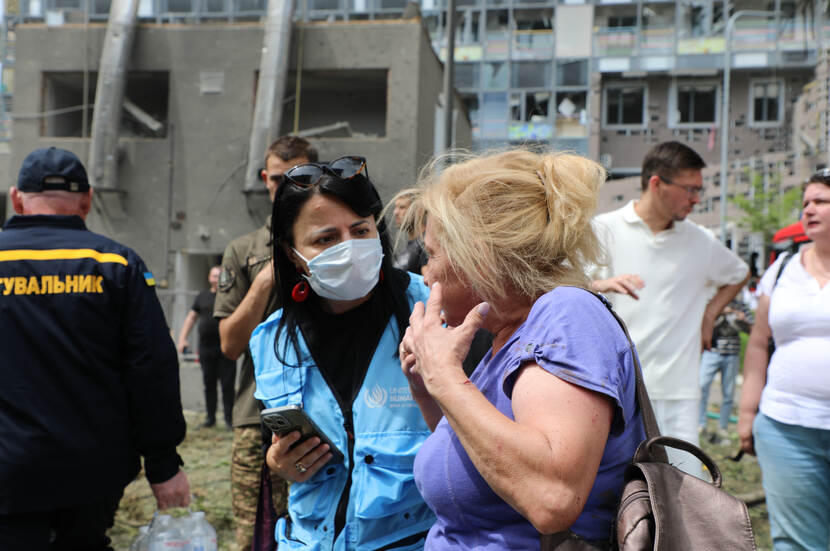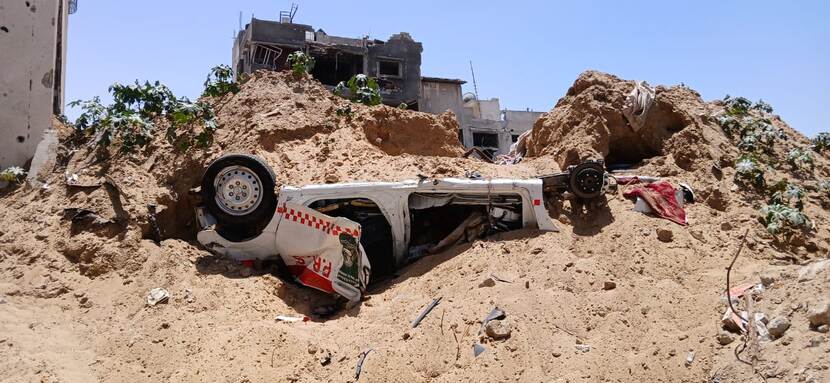Emergency aid in crisis and conflict situations: how do we protect aid workers?
Weblogs
2023 was the deadliest year on record for emergency aid workers. In 2024 there have already been several attacks on humanitarian aid workers. This must end. That is why on World Humanitarian Day we reflect on the importance of emergency aid, the safety of aid workers and the international agreements that apply.

World Humanitarian Day
On 19 August 2003 a truck bomb exploded at the United Nations headquarters in Iraq. The devastating attack killed 22 humanitarian aid workers and injured more than 100 others. The attack shocked the world, because the victims were not combatants, but people offering life-saving assistance.
Five years later the United Nations designated 19 August as World Humanitarian Day. Every year on this day extra attention is focused on people affected by crises and on the safety and security of aid workers.
What do humanitarian aid workers do?
Around the world, humanitarian aid workers help people in need. They often work under great pressure in dangerous areas. Their main aims are to save lives, prevent suffering and protect people’s dignity. Aid workers’ tasks include:
- distributing food, clean drinking water and medicines;
- providing shelter and sanitation, such as emergency toilets;
- putting hygiene measures in place to prevent disease;
- providing medical assistance;
- offering psychological help and protection.
Emergency aid workers respond quickly when a natural disaster strikes or conflict erupts. They are often employed by international organisations and NGOs such as the Red Cross, UNICEF and UNHCR. These organisations must be able to do their work safely and without restrictions. The rules on this are laid down in international humanitarian law.
What is international humanitarian law?
In times of war, rules still apply. International humanitarian law lays down rules protecting civilians who are not involved in the armed conflict. These rules also apply to aid workers, wounded combatants and prisoners of war. It also sets out agreements on access to emergency aid. For instance, humanitarian aid workers must be allowed to move freely within conflict zones in order to provide help quickly.
The main points of international humanitarian law are laid down in the Geneva Conventions and their Additional Protocols. Read more about the Geneva Conventions (in Dutch).

Why are aid workers nevertheless targeted by attacks?
In recent years the number of attacks on aid workers has risen. In fact, the number of incidents has doubled since 2022. In 2023, 280 humanitarian aid workers died, a further 224 were injured and 91 were kidnapped, according to the Aid Worker Security Report. With crises in Gaza, Sudan, Ukraine, Syria and the Sahel, this trend appears to be continuing this year. 2024 is on its way to become one of the most deadly years for humanitarian workers ever. According to the UN, in Gaza alone at least 254 aid workers have been killed between 7 October 2023 and 30 April 2024.
The security and safety of aid workers is under threat for various reasons. One factor is that the emergence of advanced weapons and drones means there is more and heavier fighting in urban areas, making it harder to differentiate between combatants and civilians. It is also becoming more common for parties to a conflict to violate the agreements laid down in international humanitarian law. It is essential that these violations are investigated and punished. Otherwise we risk a culture of impunity.
Major consequences
The threat to the safety and security of aid workers not only affects the physical and mental well-being of aid workers themselves, but also has repercussions for the people who need their help to survive. Attacks on aid workers often mean essential aid does not reach these groups. There are also consequences for the way general agreements on and principles of international cooperation and the rule of law are viewed.
What is the Netherlands doing to protect humanitarian aid workers?
The Netherlands is working with other countries to ensure that people in crisis situations receive the help they need as quickly as possible. We do this in the EU and with like-minded countries in the UN. For instance, earlier this year the Netherlands sponsored a UN Security Council resolution to expand protections for aid workers to give locally recruited personnel more protection. We also express our concern about incidents when they occur, for instance when World Central Kitchen aid workers were killed in Gaza.
In addition, the Netherlands supports the International NGO Safety Organisation (INSO). This organisation makes sure that NGOs, UN aid organisations and the Red Cross have access to up-to-date information about incidents and restrictions which may pose a risk to their staff. Lastly, the Netherlands contributes to a Clingendael Institute training programme which equips humanitarian aid workers, diplomats and aid organisation staff with the negotiation skills they need. These skills are of great importance to those working in high-stress circumstances, as they can for instance help workers gain access to conflict zones or areas affected by natural disasters.
Broad commitment to emergency aid and humanitarian diplomacyMillions of people around the world are facing emergency situations or have been forced to flee, and need urgent assistance in order to survive and rebuild their lives. That is why the Netherlands supports the work of UN aid organisations, the Red Cross and Dutch NGOs. This support is structural and therefore predictable and not linked to specific events or target groups. This enables our emergency aid partners to provide aid immediately where it is most needed. The Netherlands also contributes to the EU’s international emergency aid programmes. Read more about the Netherlands’ efforts to provide emergency aid and humanitarian diplomacy. |